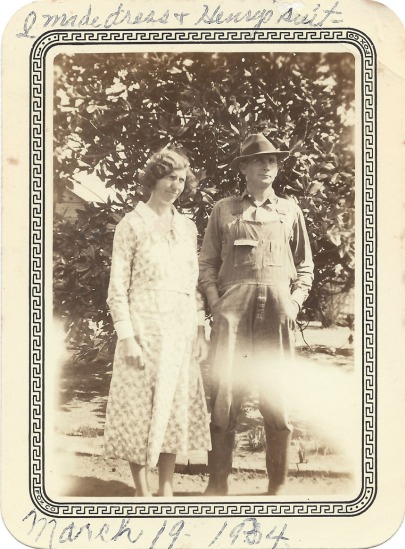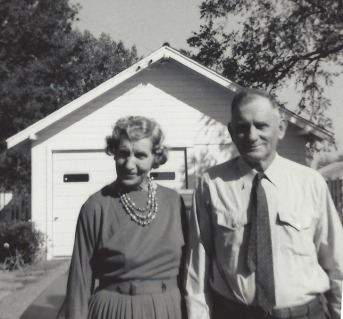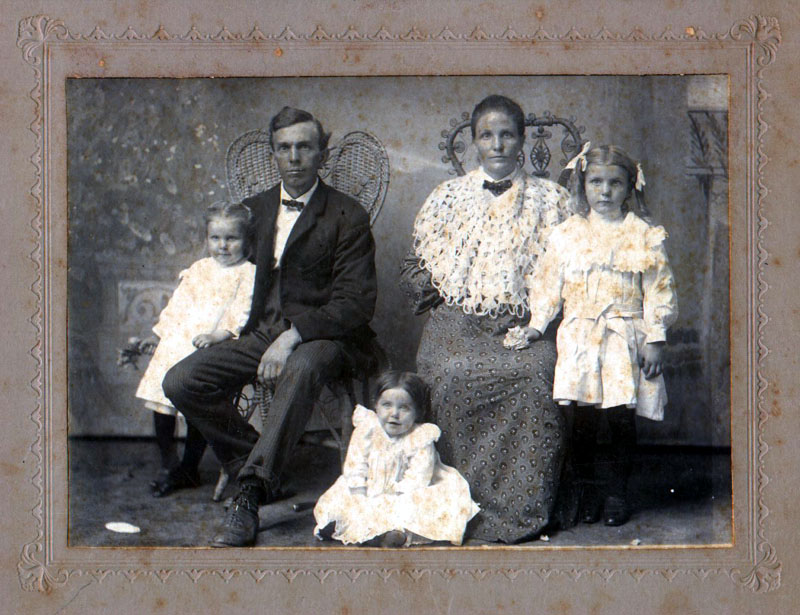It’s week 35 and it’s the end of August and time for Back to School. Of course, here in the Atlanta area they have the crazy practice of starting school super-early. School started in Fulton County, where we live, the first Monday in August! So, kids and teachers have been back pretty much a month now and are coming up on their first day off – Labor Day.
When I think about Back to School and my ancestors, there are so many people that I think of. I come from a long line of teachers in every direction. Some were young women who taught in country schools for a time until they got married. Others made a career out of teaching. Others taught school to supplement their income at different points in their lives. There were some who helped to establish schools. And many, many who just went to school.
 But, this week, I want to introduce you to Mildred Wren. You’ve already seen a picture of her and the rest of her family when I talked about her little sister Marion Wren. Mildred was the eldest of the four children of Sam Scott Wren and Pearl Hudson Wren. Sam and Pearl were married on 21 February 1900 in Laneburg, Nevada County, Arkansas. Mildred was born nine months and three days after that on 24 November 1900! After Mildred came her sisters, Norvelle and Marion, followed up by her little brother Hudson, my grandfather.
But, this week, I want to introduce you to Mildred Wren. You’ve already seen a picture of her and the rest of her family when I talked about her little sister Marion Wren. Mildred was the eldest of the four children of Sam Scott Wren and Pearl Hudson Wren. Sam and Pearl were married on 21 February 1900 in Laneburg, Nevada County, Arkansas. Mildred was born nine months and three days after that on 24 November 1900! After Mildred came her sisters, Norvelle and Marion, followed up by her little brother Hudson, my grandfather.
The Wren kids all went to school out in the country. I don’t remember a lot of stories about being in school. Based on Mildred’s 1912 report card, I get the impression that she made her way through, but wasn’t that excited about it.
 She studied Arithmetic, Grammar, Geography, Reading, Spelling, and Physiology. She was also graded on Deportment, which, not surprisingly, she excelled. Her grades overall, however, were nothing to write home about.
She studied Arithmetic, Grammar, Geography, Reading, Spelling, and Physiology. She was also graded on Deportment, which, not surprisingly, she excelled. Her grades overall, however, were nothing to write home about.
In the fall, she had a lot of half-days where she missed school, probably to help out on the farm, since she would have been almost twelve years old.
At the end of the 1914 school year, Mildred had completed what was required to get her Pupil’s Certificate for completing the course of study of the Common Schools of the State of Arkansas. That would mean that she had completed the 8th grade. Her 8th grade teacher, who signed her certificate was Glen D. Sutton.  Glen, as it turns out, was both a career teacher and a the wife of Mildred’s cousin. Glen Sutton was born in 1893 in Sutton, Nevada County, Arkansas. She married James Edgar “Edgar” Wren, Mildred’s cousin, in 1915, just the year after Mildred finished her class. Glen taught school for thirty years, herself, according to notes that Mildred made.
Glen, as it turns out, was both a career teacher and a the wife of Mildred’s cousin. Glen Sutton was born in 1893 in Sutton, Nevada County, Arkansas. She married James Edgar “Edgar” Wren, Mildred’s cousin, in 1915, just the year after Mildred finished her class. Glen taught school for thirty years, herself, according to notes that Mildred made.
 Before too long, Mildred met a dashing young guy, Henry Whitten. They fell in love and married. The two of them were made for each other. Both always had a twinkle in their eye and some kind of mischief in mind. They married in 1920 and were together until Henry’s death in 1979. When they first married, they had a house out in the country. Later on, after Mildred’s parents and sister had moved closer into the town of Prescott, Henry built a house for them across the highway from her parents. They were always a close family.
Before too long, Mildred met a dashing young guy, Henry Whitten. They fell in love and married. The two of them were made for each other. Both always had a twinkle in their eye and some kind of mischief in mind. They married in 1920 and were together until Henry’s death in 1979. When they first married, they had a house out in the country. Later on, after Mildred’s parents and sister had moved closer into the town of Prescott, Henry built a house for them across the highway from her parents. They were always a close family.
I’ve always loved how Mildred worked so hard to record memories. She has notebooks  and notebooks of the lives of her family – uncles, aunts, cousins, and all of their children. She kept scrapbooks of all of the cousins’ children, though she and Henry never had any of their own. She had lists of all of her family’s birthdays, anniversaries, and dates of death, along with the same thing for her friends.
and notebooks of the lives of her family – uncles, aunts, cousins, and all of their children. She kept scrapbooks of all of the cousins’ children, though she and Henry never had any of their own. She had lists of all of her family’s birthdays, anniversaries, and dates of death, along with the same thing for her friends.
She made notes on her photos to capture the moment as well. For example, in 1934, she made a note on the picture above that she made the dress she is wearing as well as Henry’s overalls that he’s wearing. Mildred and Henry never had money to speak of, so the made do – making what they needed, raising a fabulous garden, and raising cattle on their farm.

In 1965, Mildred and Henry went to Glen & Edgar Wren’s Golden Wedding reception, held at the home of another cousin, Willard Wren. Yes, that Glen. Glen Sutton Wren. Mildred’s 8th grade teacher. Glen & Edgar even went on to have a daughter named Mildred Wren.
But, back to school. Early in their marriage, Mildred and Henry, like many young people starting out in their lives and their married lives, took up school teaching in the country. Mildred and Henry both were licensed teachers for both primary and high school through the late 1920s at least. They taught school in little country schools – Holly Springs and Thomasville, in particular. I wish I had the years for these pictures and a list of the students, but all I have is the place. It looks like one is Thomasville in 1923 – a girl is holding a basketball that says THS 1923.
But, you know, I came a long a long time after Mildred and Henry taught school. By my time, they were already getting on in years. But the twinkle and the mischief were still there. I am sure that we will get to a story about Henry’s magic tree at some point, or about how they named the calves each season, or about all of the amazing vegetables we ate when we visited. I remember them being so proud of their nieces, my mom and aunt, and being so proud of the next generation – my two cousins, my brother, and me. I remember Mildred and Norvelle taking the bus from Prescott, Arkansas to Jackson, Tennessee for commencement when my Mom graduated from Lambuth College. I remember that even when she was in the nursing home, not feeling well at all, she still had a smile and a twinkle and wanted to hear all about how you were doing rather than say how well she was not doing.
So, back to school. Time to head back. You never know. You may find yourself cousin to your 8th grade teacher, find out she named her daughter for you, and end up going to her Golden Wedding reception! Just keep a smile on your face and a twinkle in your eye and mischief in your heart along the way.


























 was born 29 Jan 1837 in Alabama, according to family records dating from the mid- to late-1800s. I can find her in Madison County, Alabama in 1850 in the home of her parents,
was born 29 Jan 1837 in Alabama, according to family records dating from the mid- to late-1800s. I can find her in Madison County, Alabama in 1850 in the home of her parents,